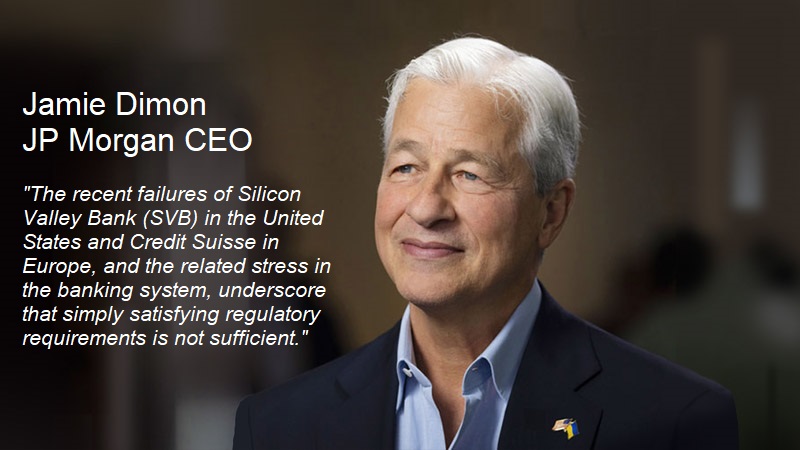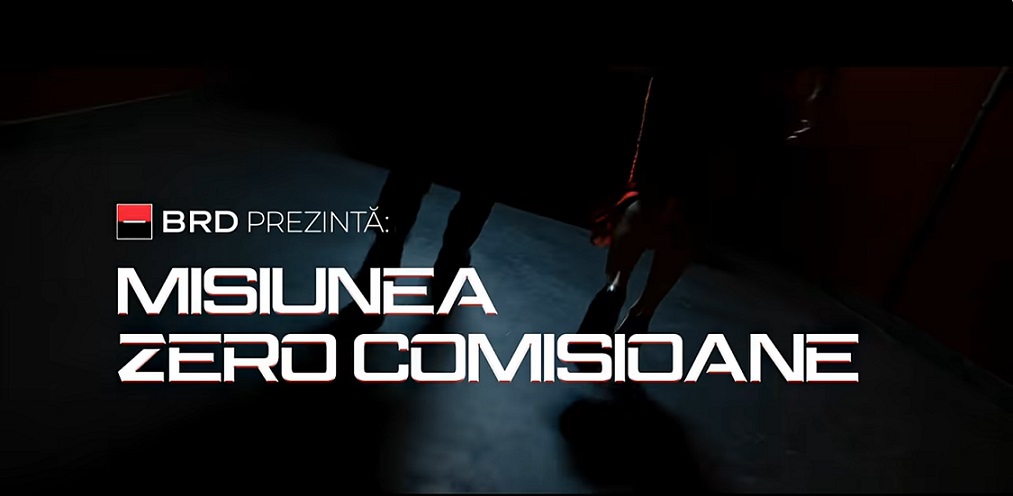JPMorgan Chase CEO’s message to shareholders: „the current crisis is not yet over, and even when it is behind us, there will be repercussions from it for years to come”

The U.S. banking crisis is ongoing and its impact will be felt for years, JPMorgan Chase & Co CEO Jamie Dimon wrote in a letter to shareholders on Tuesday. „While this crisis will pass, lessons will be learned, which will result in some changes to the regulatory system.” he says.
Find below what he believes about banking turmoil and regulatory goals.
„The recent failures of Silicon Valley Bank (SVB) in the United States and Credit Suisse in Europe, and the related stress in the banking system, underscore that simply satisfying regulatory requirements is not sufficient. Risks are abundant, and managing those risks requires constant and vigilant scrutiny as the world evolves. Regarding the current disruption in the U.S. banking system, most of the risks were hiding in plain sight.
Interest rate exposure, the fair value of held-to-maturity (HTM) portfolios and the amount of SVB’s uninsured deposits were always known – both to regulators and the marketplace. The unknown risk was that SVB’s over 35,000 corporate clients – and activity within them – were controlled by a small number of venture capital companies and moved their deposits in lockstep. It is unlikely that any recent change in regulatory requirements would have made a difference in what followed. Instead, the recent rapid rise of interest rates placed heightened focus on the potential for rapid deterioration of the fair value of HTM portfolios and, in this case, the lack of stickiness of certain uninsured deposits.
Ironically, banks were incented to own very safe government securities because they were considered highly liquid by regulators and carried very low capital requirements. Even worse, the stress testing based on the scenario devised by the Federal Reserve Board (the Fed) never incorporated interest rates at higher levels. This is not to absolve bank management – it’s just to make clear that this wasn’t the finest hour for many players. All of these colliding factors became critically important when the marketplace, rating agencies and depositors focused on them.
As I write this letter, the current crisis is not yet over, and even when it is behind us, there will be repercussions from it for years to come. But importantly, recent events are nothing like what occurred during the 2008 global financial crisis (which barely affected regional banks). In 2008, the trigger was a growing recognition that $1 trillion of consumer mortgages were about to go bad – and they were owned by various types of entities around the world. At that time, there was enormous leverage virtually everywhere in the financial system. Major investment banks, Fannie Mae and Freddie Mac, nearly all savings and loan institutions, off-balance sheet vehicles, AIG and banks around the world – all of them failed. This current banking crisis involves far fewer financial players and fewer issues that need to be resolved.
These failures were not good for banks of any size.
Any crisis that damages Americans’ trust in their banks damages all banks – a fact that was known even before this crisis. While it is true that this bank crisis “benefited” larger banks due to the inflow of deposits they received from smaller institutions, the notion that this meltdown was good for them in any way is absurd.
Let’s be very thoughtful in our reaction to recent events.
While this crisis will pass, lessons will be learned, which will result in some changes to the regulatory system. However, it is extremely important that we avoid knee-jerk, whack-a-mole or politically motivated responses that often result in achieving the opposite of what people intended. Now is the time to deeply think through and coordinate complex regulations to accomplish the goals we want, eliminating costly inefficiencies and contradictory policies. Very often, rules are put in place in one part of the framework without appreciating their consequences in combination with other regulations. America has had, and continues to have, the best and most dynamic financial system in the world – from various types of investors to its banks, rule of law, investor protections, transparency, exchanges and other features. We do not want to throw the baby out with the bath water.
We should have common goals on how we want the banking system to work.
We want to strengthen regional, midsized and community banks, which are essential to the American economic system. They fill a critical role in small communities, offering local knowledge and local relationships that some large banks simply can’t provide – or can’t provide cost-effectively. Overall, we want to maintain the extraordinary strength this tiered system affords. JPMorgan Chase directly supports this goal as we are one of the largest bankers in America to regional and community banks. We bank approximately 350 of America’s 4,000+ banks across the country. This means we make loans to them or raise capital for them. In addition, we process payments for them, finance some of their mortgage activities, advise them on acquisitions, provide them with interest rate swaps and foreign exchange, and buy and sell securities for them. And we also finance their local communities (think hospitals, schools and larger companies) in ways they cannot.
We need large, complex banks to continue to play a critical role in the U.S. and global financial system. And we need to recognize that they do so in a way regional banks can’t. Large banks are complex not because they want to be, but because they operate in complex global markets. Regional banks simply cannot manage the scale and complexity of transactions in 50 or 60 countries around the world to help some of America’s best and largest companies accomplish their goals. Think of equity, debt, M&A, research, swaps, foreign exchange, large payments systems, global custody and so on. It takes a global workforce with deep expertise and significant capabilities to provide these services. These large global banks finance not just the world’s largest companies but the world’s development institutions and even countries. Having some of the best large, complex banks in the world is essential to the success of America’s biggest companies, its economic system and its global competitiveness, which says nothing against the importance of having great midsized and community banks as well. And contrary to what some say – to be safe, a global bank needs both huge economies of scale and the strength of diversified earnings streams.
We should want a system in which a bank failure does not cause undue panic and financial harm. While you don’t want banks to fail all the time, it should be allowed to happen and the resolution should follow a completely prescribed process. In almost all bank failures, uninsured deposits never resulted in lost money – but the very fear of loss can cause a run on any bank having characteristics similar to a bank that has failed. Resolution and recovery regulations did not work particularly well during the recent crisis – we should bring clarity and reassurance to both the unwinding process and measures to reduce the risk of additional bank runs. It should also be noted that banks pay for any bank failure (through fees paid to the Federal Deposit Insurance Corporation) as they pay for the whole financial regulatory system. And yes, while these costs are ultimately passed on to their customers – that is true for all industries – the cost is just the price of implementing proper regulations.
We want proper transparency and strong regulations. However, it should be noted that regulations, the supervisory regime and the resolution regime currently in place did not stop SVB and Signature Bank from failing — and from causing systemwide issues. We should not aim for a regulatory regime that eliminates all failure but one that reduces the chance of failure and the odds of contagion. We should carefully study why this particular situation happened but not overreact. Strong regulations should not only minimize bank failures but also help to maintain the strength of banks as both the guardians of the financial system and engines that finance the great American economic machine.
We should want market makers to have the ability to effectively intermediate, particularly in difficult markets, with central banks only stepping in during exceptional situations. In the last few years, we have had many situations in which disruptions in the market were, in my opinion, largely caused by certain regulations that did not improve the safety of the market maker but, instead, damaged the safety of the whole system. In addition, many of the new “shadow bank” market makers are fair-weather friends – they do not step in to help clients in tough times.
We need banks to be there for their clients in tough times. And they have been. Banks can flex their capital and provide their clients with a lot of loans and liquidity when they really need it. For example, at the beginning of the COVID-19 crisis in March 2020, banks deployed over $500 billion in liquidity for clients and $500 billion in PPP loans – and this does not include banks’ share of the nearly $2 trillion in loans that entered forbearance. Banks also play a unique and fundamental role in the transmission of monetary policy because deposits in banks can be loaned out, effectively “creating” money. Some regulations and some accounting rules have become too procyclical and make it harder to do this.
Regulation, particularly stress testing, should be more thoughtful and forward looking. It has become an enormous, mind-numbingly complex task about crossing t’s and dotting i’s. For example, the Fed’s stress test focuses on only one scenario, which is unlikely to happen. In fact, this may lull risk committee members at any institution into a false sense of security that the risks they are taking are properly vetted and can be easily handled. A less academic, more collaborative reflection of possible risks that a bank faces would better inform institutions and their regulators about the full landscape of potential risks.
We should decide a priori what should stay in the regulatory system and what shouldn’t. There are reasons for certain choices, and they should not be the accidental outcome of uncoordinated decision making. Regulatory arbitrage is already forcing many activities, from certain types of lending to certain types of trading, outside the banking system. Among many questions that need definitive answers, a few big ones would be: Do you want the mortgage business, credit and market-making, along with other essential financial services, inside the banking system or outside of it? What would be the long-term effect of that choice? Under the new scheme, would nonbank credit-providing institutions be able to provide credit when their clients need them the most? I personally doubt that many of them could.
We need banks to be attractive investments. It is in the interest of the financial system that banks not become “un-investable” because of uncertainty around regulations that affect capital, profitability and long-term investing. Erratic stress test capital requirements and constant uncertainty around future regulations damage the banking system without making it safer. While it is perfectly reasonable that a bank refrain from stock buybacks, dividends or growth under certain circumstances, it would be far better for the entire banking system if these rules were clearly enumerated (i.e., stipulate that a bank needs to reduce its buybacks and dividend if they breach certain thresholds).
If done properly, banking regulations could be calibrated — adding virtually no additional risk — to make it easier for banks to make loans, intermediate markets, finance the economy, manage a run on their bank and fail if need be. When it comes to political debate about banking regulations, there is little truth to the notion that regulations have been “loosened,” at least in the context of large banks. (To the contrary, our capital requirements have been increasing for years, as our fortress balance sheet chart shows in the introduction.)
The debate should not always be about more or less regulation but about what mix of regulations will keep America’s banking system the best in the world, such as capital and leverage ratios, liquidity and what counts as liquidity, resolution rules, deposit insurance, securitization, stress testing, proper usage of the discount window, tailoring and other requirements (including potential requirements on shadow banks). Because of the recent problems, we can add to this mix the review of concentrated customers, uninsured deposits and potential limitations on the use of HTM portfolios. Ideally, new rules and regulations would also make it easier for banks to provide credit in tougher times.”
Dariusz Mazurkiewicz – CEO at BLIK Polish Payment Standard
Banking 4.0 – „how was the experience for you”
„To be honest I think that Sinaia, your conference, is much better then Davos.”
Many more interesting quotes in the video below:









